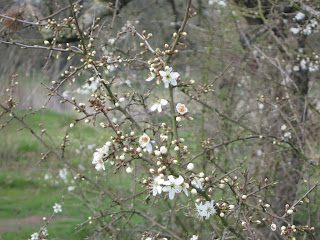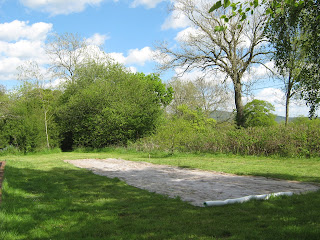Monday 16 May 2016
One of the nice things about rough patches is that they know when to lie low! After the showy clouds of colour and architectural forms of winter, they are cut back in March and the attention is drawn to beauty on the edges of the plot, such as emerging Blackthorn, and later on, at the time of writing in May, they are neat, lush green ovals separated by mown pathways, a lovely deep carpet leading the eye onwards to the foaming blossom of the orchard trees beyond.
Moss and plant stems and fibres revealed by the March 'clear-up' have been taken away by birds for their nests, now there's different activity amongst the cool, damp verdure: voles, mice, beetles, and bees visiting primroses and cowslips. Soon there will be a grass snake, even perhaps a slow-worm. On a hot day, the female pheasants and other birds love pecking about in there, or flopping panting on the grass in the sun. I can see the willow-herb, teazels, and various kinds of thistles beginning their rush to the sky, and enjoy the smaller birds' acrobatic use of wild rose branches and dogwood stems, en route to their nests (3 sparrows on the house) or the bird feeder (marsh tits still visiting for seed).
I have also laboured in several other ways this winter to develop the 'wild life' here - firstly we have dug, removed turf from and cultivated a 40 square metre patch on the lawn and have now sown it with perennial wild flowers and plants for a wet clay soil, adding, for this first year, a 'cornfield mix' with extra poppies for good luck! It is now covered by a light fleece otherwise I think the seeds would quickly be eaten. Eventually it will form a layer between the hedge and the rainwater pond, allowing a corridor behind it for passing animals and birds ( I often see deer going that way, to the woods beyond).
That was the hard physical labour - also I have spent many hours at the computer filling in forms and consulting regulations and guidance in order to prepare new woodland plans, creating more wildlife corridors that will enable the joining of ancient and new woodland around the farm, and hopefully to the hills. The garden is very much a part of this, with its glades, pathways and natural plantings - a bit like living at the centre of the spiderweb! Whatever the size of garden, it seems that by planting more naturally and considering the communities of 'wild life' using these areas, one's consciousness will inevitably be drawn to connections beyond, in a manner which brings balance and health into one's practical relationship with the wider world, an affirmation of hope and caring without which I would find it difficult to thrive. Besides, its fun!
Subscribe to:
Posts (Atom)


